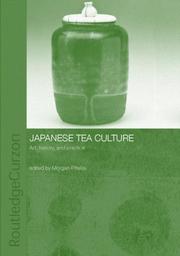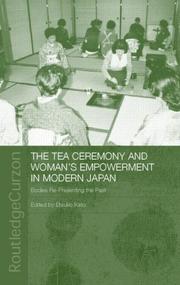| Listing 1 - 7 of 7 |
Sort by
|
Book
Year: 2018 Publisher: Honolulu : University of Hawaiʻi Press,
Abstract | Keywords | Export | Availability | Bookmark
 Loading...
Loading...Choose an application
- Reference Manager
- EndNote
- RefWorks (Direct export to RefWorks)
The overwhelming majority of tea practitioners in contemporary Japan are women, but there has been little discussion on their historical role in tea culture (chanoyu). In Cultivating Femininity, Rebecca Corbett writes women back into this history and shows how tea practice for women was understood, articulated, and promoted in the Edo (1603-1868) and Meiji (1868-1912) periods. Viewing chanoyu from the lens of feminist and gender theory, she sheds new light on tea's undeniable influence on the formation of modern understandings of femininity in Japan. Cultivating Femininity offers a new perspective on the prevalence of tea practice among women in modern Japan. It presents a fresh, much-needed approach, one that will be appreciated by students and scholars of Japanese history, gender, and culture, as well as by tea practitioners.
Book
ISBN: 1282486128 1283265761 9786612486128 9786613265760 9004212981 9789004212985 9781905246748 1905246749 9781905246755 Year: 2009 Publisher: Folkestone, UK : Global Oriental,
Abstract | Keywords | Export | Availability | Bookmark
 Loading...
Loading...Choose an application
- Reference Manager
- EndNote
- RefWorks (Direct export to RefWorks)
This provoking new study of the Japanese tea ceremony ( chanoyu ) examines the ideological foundation of its place in history and the broader context of Japanese cultural values where it has emerged as a so called ‘quintessential’ component of the culture. It was in fact, Sen Soshitsu Xl, grandmaster of Urasenke, today the most globally prominent tea school, who argued in 1872 that tea should be viewed as the expression of the moral universe of the nation. A practising teamaster himself, the author argues, however, that tea was many other things: it was privilege, politics, power and the lever for passion and commitment in the theatre of war. Through a methodological framework rooted in current approaches, he demonstrates how the iconic images as supposedly timeless examples of Japanese tradition have been the subject of manipulation as ideological tools and speaks to presentations of cultural identity in Japanese society today.
Japanese tea ceremony --- Japanese tea ceremony. --- Japanese --- Social aspects. --- Ethnic identity.
Book
ISBN: 9784866581118 Year: 2022 Publisher: Tokyo, Japan : Japan Publishing Industry Foundation for Culture,
Abstract | Keywords | Export | Availability | Bookmark
 Loading...
Loading...Choose an application
- Reference Manager
- EndNote
- RefWorks (Direct export to RefWorks)
Why is the tea-room entrance, or nijiriguchi, so narrow? How did the practice of "passing the bowl," or mawashinomi, come about? And what hidden meaning lies behind the ritual purification of hands and mouth, or chōzu?Chanoyu, the art of preparing tea, developed against a backdrop of social turmoil in late medieval Japan. Through the singular figure of Sen no Rikyū, it found expression as wabi-cha, or wabi tea, the foundation of Japanese tea culture today. Here, scholar and curator Kumakura Isao investigates the unique cultural value of tea. He examines its rituals and behaviors, elaborates its structure, spaces, and style, and delves into the history of everything from the tea whisk to the tea room itself. Drawing on folklore studies and performing-arts history, Kumakura develops a new perspective on Japan's culture of tea.
Book
ISBN: 1350014044 1350014001 9781350014046 9781350014008 Year: 2018 Publisher: London : Bloomsbury Academic,
Abstract | Keywords | Export | Availability | Bookmark
 Loading...
Loading...Choose an application
- Reference Manager
- EndNote
- RefWorks (Direct export to RefWorks)
"By examining chanoyu - the custom of consuming matcha tea - in the Meiji period, Gathering for Tea in Modern Japan investigates the interactions between intellectual and cultural legacies of the Tokugawa period and the incoming influences of Western ideas, material cultures and institutions. It explores the construction of Japan's modern cultural identity, highlighting the development of new social classes, and the transformation of cultural practices and production-consumption networks of the modern era. Taka Oshikri uses a wealth of Japanese source material - including diaries, newspaper, journal articles, maps, exhibition catalogues and official records - to explore the intricate relationships between the practice and practitioners of different social groups such as the old aristocracy, the emerging industrial elite, the local elite and government officials. She argues that the fabrication of a cultural identity during modernisation was influenced by various interest groups, such as the private commercial sector and foreign ambassadors. Although much is written on the practice of chanoyu in the pre-Tokugawa period and present-day Japan, there are few historical studies focusing on the late 19th and early 20th centuries. Gathering for Tea in Modern Japan thus makes a significant contribution to its field, and will be of great value to students and scholars of modern Japanese social and cultural history."--Bloomsbury Publishing.
Japanese tea ceremony --- Social classes --- Group identity --- History --- Japan

ISBN: 9780415438278 0415438276 9780415296878 0415296870 1315888076 1134535317 9781134535316 9781315888071 1299998135 9781299998131 9781134535453 1134535457 9781134535385 1134535384 Year: 2003 Publisher: London ; New York : RoutledgeCurzon,
Abstract | Keywords | Export | Availability | Bookmark
 Loading...
Loading...Choose an application
- Reference Manager
- EndNote
- RefWorks (Direct export to RefWorks)
From its origins as a distinct set of ritualised practices in the sixteenth century to its international expansion in the twentieth, tea culture has had a major impact on artistic production, connoisseurship, etiquette, food, design and more recently, on notions of Japaneseness. The authors dispel the myths around the development of tea practice, dispute the fiction of the dominance of aesthetics over politics in tea, and demonstrate that writing history has always been an integral part of tea culture.
Japanese tea ceremony --- Tea --- History --- Cha-no-yu --- Tea ceremony, Japanese --- Drinking customs --- Chashitsu (Japanese tearooms) --- J6876 --- Japan: Artistic games and pastime -- tea ceremony (sadō, chadō, cha no yu) --- Japanese tea ceremony. --- Cérémonie du thé --- Thé --- History. --- Histoire
Book
ISBN: 9780804784795 0804784795 9780804778664 0804778663 9780804778671 0804778671 Year: 2012 Publisher: Stanford, Calif. : Stanford University Press,
Abstract | Keywords | Export | Availability | Bookmark
 Loading...
Loading...Choose an application
- Reference Manager
- EndNote
- RefWorks (Direct export to RefWorks)
The tea ceremony persists as one of the most evocative symbols of Japan. Originally a pastime of elite warriors in premodern society, it was later recast as an emblem of the modern Japanese state, only to be transformed again into its current incarnation, largely the hobby of middle-class housewives. How does the cultural practice of a few come to represent a nation as a whole? Although few non-Japanese scholars have peered behind the walls of a tea room, sociologist Kristin Surak came to know the inner workings of the tea world over the course of ten years of tea training. Here she offers the first comprehensive analysis of the practice that includes new material on its historical changes, a detailed excavation of its institutional organization, and a careful examination of what she terms "nation-work"—the labor that connects the national meanings of a cultural practice and the actual experience and enactment of it. She concludes by placing tea ceremony in comparative perspective, drawing on other expressions of nation-work, such as gymnastics and music, in Europe and Asia. Taking readers on a rare journey into the elusive world of tea ceremony, Surak offers an insightful account of the fundamental processes of modernity—the work of making nations.

ISBN: 113437237X 0415317037 0203748875 1280025379 9780203748879 9786610025374 6610025371 9780415317030 9781134372379 9781134372324 1134372329 9781134372362 1134372361 9780415652186 0415652189 9781280025372 Year: 2004 Publisher: London ; New York, NY : RoutledgeCurzon,
Abstract | Keywords | Export | Availability | Bookmark
 Loading...
Loading...Choose an application
- Reference Manager
- EndNote
- RefWorks (Direct export to RefWorks)
The subject of the tea ceremony is well researched both in and outside of Japan, but the women who practice it are hardly ever discussed. The Tea Ceremony and Women's Empowerment in Modern Japan rectifies this by discussing the meaning of the Japanese tea ceremony for women practitioners in Japan from World War II to the present day. It examines how lay tea ceremony practitioners have been transforming this cultural activity while being, in turn, transformed by it.
Japanese tea ceremony. --- Women --- Cha-no-yu --- Tea ceremony, Japanese --- Drinking customs --- Chashitsu (Japanese tearooms) --- Social conditions. --- Japan --- Social conditions --- Sociology of culture --- Sociology of minorities --- Community organization --- Participation --- Rituals --- Book --- Culture --- Empowerment
| Listing 1 - 7 of 7 |
Sort by
|

 Search
Search Feedback
Feedback About UniCat
About UniCat  Help
Help News
News